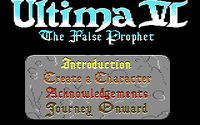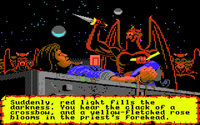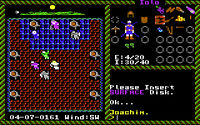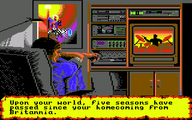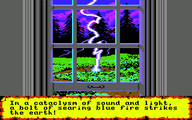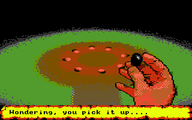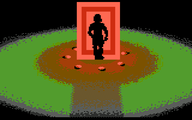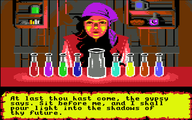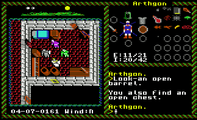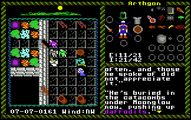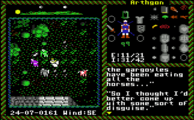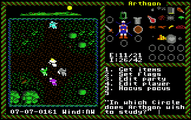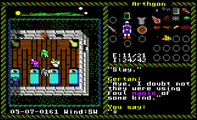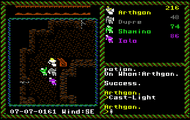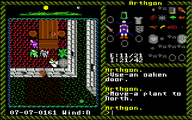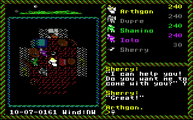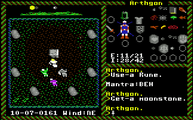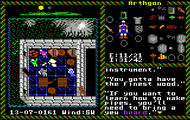C64-port of Ultima VI
Ultima VI was ported to several platforms, including the Commodore 64 (C64).
History[edit]
Briefly, Richard Garriott had wanted to write Ultima VI using the 8-bit Apple II as a base, as he had done with each of the previous Ultimas. However, after a short amount of time and for various reasons (see this article's Discussion page), Origin moved the primary development platform to an 80286-based IBM PC with VGA graphics and soundcard. The game's creative progress went very fast after that decision.
However, after the game was finished and in the stores, the matter of ports came up; the PC, though it was increasingly dominant in the market, still had its competitors at the time, especially in the gaming market. While ports for the 16-bit Amiga and Atari ST computers were straightforward enough, as they could easily handle a game of this scale (albeit with some minor compromises in audiovisual quality), there was one older 8-bit platform that was too tempting for Origin to pass up: the Commodore 64, which despite its age and increasing limitations still commanded a sizeable percentage of the home computer market at that time. As a bonus, a C64-port would mean the complete second trilogy would be available on the platform, something only the PC, Atari ST and Commodore Amiga could otherwise boast (since the planned Apple II version had been stillborn). However, although the C64 was theoretically a more powerful system than the Apple II, such a conversion faced a similar problem to that which Garriott had dealt with early in Ultima VI's development: Ultima had become so complex and demanding by this point that it had, simply put, outgrown the 8-bit systems of old.
Regardless of the difficulties involved, Origin got the help from Axel of Imagitec Design to somehow port the game to the C64. The only 8-bit version of Ultima VI (and the last 8-bit mainline Ultima), the C64-port was released in early 1991, just about one year after the release of the original.
Technical[edit]
Porting a game of this size and complexity to the C64, with its limitations (64kb memory, approximately 1MHz CPU speed, graphics with 16 fixed colors at 160x200 resolution with restrictions on color placement, and disks formatted for a maximum of 170KB per side), required many compromises and sacrifices. Unlike Ultima V, there is no enhanced version for the C64's more capable successor, the Commodore 128, that could have taken advantage of the system's larger memory capacity.
While the PC version provides an option to run directly from its floppy disks (for systems lacking a hard drive), the C64 release requires it. The game shipped on three double-sided 5¼" disks totaling just under one megabyte of data (roughly a quarter of the PC original). The disk sides are named:
- Surface
- Dungeon
- Populace A, Populace B and Populace C
- Game
The "Surface" disk contains the overworld of Britannia and the Realm of the Gargoyles, divided into cities and wilderness, with a noticeable loading time when stepping from one into the other. "Dungeon" contains all dungeons in the game in their entirety, except for dialogues. Character dialogue in turn is stored across the three "Populace" disks. Lastly, the "Game" disk holds the introduction, endgame, and character creation sequences, and is also used to initially boot the game and store the saved game.
Although the division of areas is mostly logical to minimize disk-swapping, the handling of conversations is more complicated. The method they were forced to use requires the player to perform the following procedure for every in-game conversation, from Lord British down to random characters:
- The player attempts to speak to a character.
- The appropriate "Populace" disk must be inserted, and its data loaded.
- The player must then re-insert the "Surface" disk ("Dungeon" when being in a dungeon) and wait through another disk access.
- The conversation will then begin.
As such, character conversations are a very time-consuming process, exacerbated by the slow speed and data-transfer rate of the standard Commodore 1541 floppy drive (while there were faster disk drives available for the C64, none were 100% compatible with the 1541 and thus were not guaranteed to work with all software on the market). Additionally, Ultima VI on the C64 does not support the use of more than one disk drive, unlike Ultima IV and Ultima V, which support two and therefore require less disk-swapping. Additional fastloaders also do not work with the game and cause a crash.
The control scheme of this port is somewhat altered from the PC version's allowance for both a mouse and keyboard. Here there is no icon-driven, mouse-controlled interface, meaning all actions are restricted to keyboard commands (e.g. "U" for use, "D" for drop, etc.) as in the previous five Ultima games. The joystick is used for movement and also for targeting a crosshair at objects the player wishes to act upon; a keyboard command switches this crosshair between the main window and the inventory panel and additional commands switch between the various inventory and status screens.
Despite all these issues, gaming magazines at the time praised the port. The influential British magazine Zzap!64 gave the Commodore 64 conversion an overwhelmingly positive (98%) review in their May 1991 issue.
What is Missing[edit]
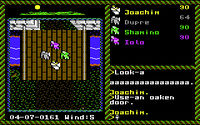
Due to the limitations of the C64, the developers were forced to eliminate a number of gameplay elements to make the conversion possible:
- The option for a Character Transfer was removed entirely.
- The game features no sound effects and, aside from the introduction and endgame sequences, no music.
- There are no character portraits.
- The number of usable items has been reduced. For example, there are no powder kegs (meaning that doors have to be blasted open with the Explosion spell).
- The number of spells has been reduced. The list of missing spells is below.
- The size of the party is reduced, from 8 to 6.
- As a space-saving measure, the conversations have been streamlined.
- Horse riding is eliminated. The programmers use the excuse that the gargoyles have eaten all the horses; Smith is the only exception, although he is disguised as a cow of all things (cows are in the port).
- Peering is impossible. Peer gems do not exist, along with the equivalent spell. This makes mapping a lot more difficult.
- The interactivity of the game world is reduced. For example, the player cannot look into closets to find clothing, and telescopes cannot be used.
- Casting can be done without a spellbook. There is still one in the game, but it has no use.
- The world itself is less detailed. For example, many decorative items are missing, and there are no tables (when one is needed, wooden-floor tiles are reused for this purpose). Also, there are no bags or chests; they are all replaced by barrels.
- The introduction has less text and some pictures are missing.
- The built-in cheat menu is reduced in functionality, and it is not accessed by saying specific words to a certain other party member as in the PC version, but rather by talking to oneself and saying another set of specific words (the ability to talk to oneself is new in the C64 version).
- The number of weapons has been reduced, as well as some of the armour (for example, ring mail is not available). The triple crossbow also does not exist.
Missing Spells[edit]
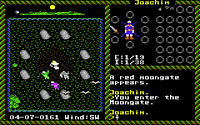
1st Circle
2nd Circle
3rd Circle
4th Circle
5th Circle
6th Circle
7th Circle
8th Circle
- Eclipse
- Slime
- Armageddon (This spell is however still available in cheat menu)
Gameplay Changes[edit]
Some of the gameplay changes that were made cannot be explained with technical reasons and are a deliberate change made by the programmers.
- There are several invisible levers. They cannot be seen but used. The C64-annex of the Ultima VI clue book thankfully shows, where they are exactly.
- Two of these levers are in the basement of Sutek's castle. These are found on the northern wall, where in the PC version are four levers.
- The first level of dungeon Wrong/Covetous has three of these levers strewn throughout it.
- The fourth level of Stonegate has one invisible lever (for the force field) on the northern wall of the center room.
- Phoenix's belt is simply hidden under some flowers in her house and does not need to be pickpocketed, so the programmers removed the spell as well.
- For unknown reasons, the shipwreck of the unnamed pirate was moved to a different island at the coordinates 1A8 3A8.
- On Dagger Isle, another map piece may be found in the barrel instead of behind the harpsichord.
- Explosion is necessary to open the locked door of the treasure room on Treasure Island, because of the absence of powder kegs.
Trivia[edit]
- The disk images of the game being used for emulation were all sourced from one specific set of game disks. Sadly, the Populace disks had a bug that caused some dialogue to be mixed up, rendering the dialogue inaccessible (notably Xiao). New disk images with the label "Htw-fixed" from a new, clean source circumvent the problem.
- A strange bug in emulation is, that often instead of the actual name, the character label when looking at and in dialogue says: "Aaaaaaaaaaa". The reason why this happens in emulation is unknown.
Gallery[edit]
The Avatar at home
Entering the moongate
The Gypsy
Meeting Penumbra
Clever disguise, Smith!
Visiting the wounded in Cove
Finding the Rune of Justice
Sherry joins
A shrine is freed
Meeting Julia
